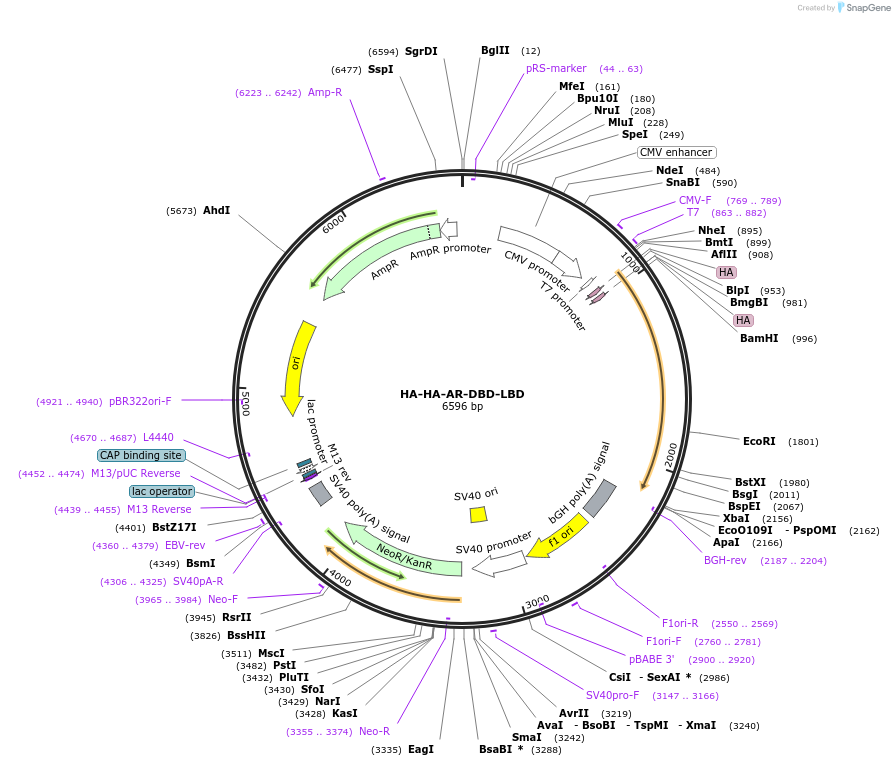HA-HA-AR-DBD-LBD
(Plasmid
#171237)
-
PurposeMammalian expression of 2xHA-tagged human androgen receptor trancate: AR DNA-bindind domain and Ligand-binding domain (DBD-LBD)
-
Depositing Lab
-
Sequence Information
Ordering
| Item | Catalog # | Description | Quantity | Price (USD) | |
|---|---|---|---|---|---|
| Plasmid | 171237 | Standard format: Plasmid sent in bacteria as agar stab | 1 | $89 | |
Backbone
-
Vector backbonepcDNA3.1(+)-kozakHAHA
- Backbone size w/o insert (bp) 5500
-
Vector typeMammalian Expression, Bacterial Expression
-
Selectable markersNeomycin (select with G418)
Growth in Bacteria
-
Bacterial Resistance(s)Ampicillin, 100 μg/mL
-
Growth Temperature37°C
-
Growth Strain(s)DH5alpha
-
Copy numberHigh Copy
Gene/Insert
-
Gene/Insert name2xHA-tagged human androgen receptor trancate:DNA-binding domain and Ligand-binding domain
-
Alt nameHA-HA-AR-DBD-LBD
-
Alt name2xHA-AR-DBD-LBD
-
SpeciesH. sapiens (human)
-
Insert Size (bp)1200
-
MutationAR truncate
-
Entrez GeneAR (a.k.a. AIS, AR8, DHTR, HUMARA, HYSP1, KD, NR3C4, SBMA, SMAX1, TFM)
- Promoter CMV
-
Tag
/ Fusion Protein
- HA (N terminal on backbone)
Cloning Information
- Cloning method Restriction Enzyme
- 5′ cloning site BamHI (unknown if destroyed)
- 3′ cloning site XbaI (unknown if destroyed)
- 5′ sequencing primer CMV_fwd_primer
- (Common Sequencing Primers)
Terms and Licenses
-
Academic/Nonprofit Terms
-
Industry Terms
- Not Available to Industry
Trademarks:
- Zeocin® is an InvivoGen trademark.
Depositor Comments
For cloning purpose, an "A" nucleotide was inserted right after BamHI site in the vector backbone by DNA mutagensis to change the open reading frame.
These plasmids were created by your colleagues. Please acknowledge the Principal Investigator, cite the article in which the plasmids were described, and include Addgene in the Materials and Methods of your future publications.
-
For your Materials & Methods section:
HA-HA-AR-DBD-LBD was a gift from Steven Balk (Addgene plasmid # 171237 ; http://n2t.net/addgene:171237 ; RRID:Addgene_171237) -
For your References section:
Protein phosphatase 1 suppresses androgen receptor ubiquitylation and degradation. Liu X, Han W, Gulla S, Simon NI, Gao Y, Cai C, Yang H, Zhang X, Liu J, Balk SP, Chen S. Oncotarget. 2016 Jan 12;7(2):1754-64. doi: 10.18632/oncotarget.6434. 10.18632/oncotarget.6434 PubMed 26636645



